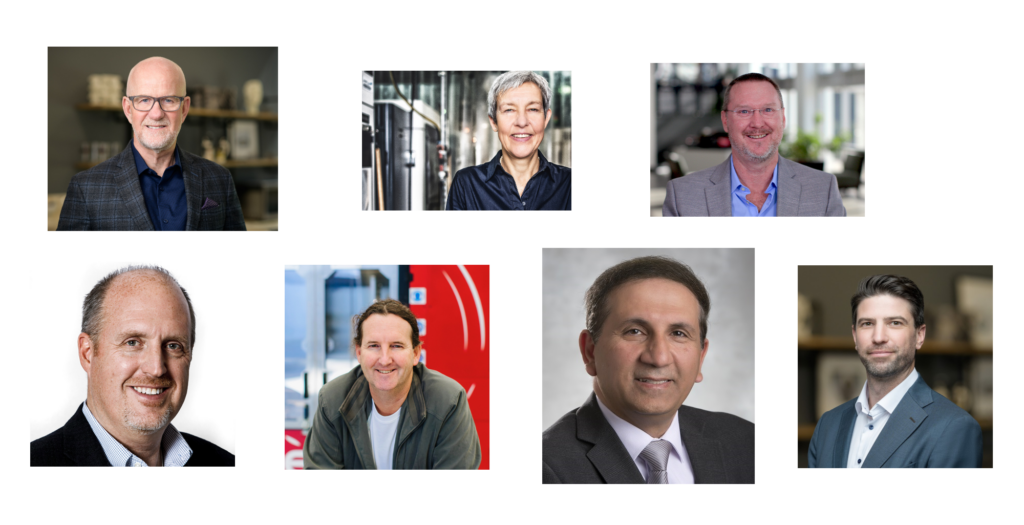Exclusive insights from the experts at EOS, 3D Systems, Materialise and more on the year ahead in 3D printing.
Is there any chance that 2025 will be a quieter, more predictable year than 2024?
Between the new administration in the United States, the continuation of international conflicts and the ever-present threat of climate change, the smart money seems firmly on, “No.”
Of course, living in interesting times need not be seen as a curse, particularly when viewed through the lens of industrial and technological advancement. Crises beget opportunities – to paraphrase another apocryphal expression – and there’s no better proof of that today than in the 3D printing industry.
Engineering.com wrapped up last year’s additive manufacturing (AM) coverage by sitting down with some of the leading minds in the industry to gather their unique perspectives on the ups and downs of AM in 2024. At the same time, we also asked them to think ahead to this year and make some predictions about what we should look forward to as well as what to be wary of in 2025.

Here’s what they had to say.
Meeting additive manufacturing challenges in 2025
EOS on rebuilding trust
“Rebuilding confidence is key. Positive publicity will come from increased market demand and improved financials for publicly traded companies. The use cases being developed by Greg and the Additive Minds team are extraordinary. The potential for growth is immense, and that’s what will drive the industry forward.”
–Glynn Fletcher, President, EOS North America
“I agree. The key is to demonstrate measurable, practical success and to focus on delivering real value to customers. That’s how we’ll rebuild trust and grow the industry.”
-Gregory Hayes, SVP Global, Additive Minds
3D Systems on becoming more transparent
“It’s all about data. We need to back up our claims with hard evidence. For example, if we produce a part, we should test it across multiple machines, measure critical parameters, and demonstrate consistent performance. We also need to understand the environments where our parts will be used. For instance, will cleaning chemicals degrade the part’s properties? Identifying and addressing these challenges is crucial.
“It’s equally important to be transparent about our successes and limitations. If we’ve developed a solution that works for a specific application, we should celebrate that success without exaggeration. Grounded, honest communication builds trust and lays the foundation for long-term growth. By focusing on data, application-specific solutions, and transparency, we can create true successes that benefit both our industry and our customers.”
-Marty Johnson, VP of Product and Technical Fellow, 3D Systems
Boston Micro Fabrication on building sustainable business models
“The trick is to push the boundaries while building a sustainable business model. Much of the venture investment industry is built around a ‘go big or go home’ strategy. That is an attractive approach for VC portfolios (many fail, but there are a few big wins). But, a more measured approach, proving technology viability and testing market acceptance step by step can pave the way for a more sustainable and profitable business in the longer term.”
-John Kawola, CEO, Boston Micro Fabrication
SPEE3D on attaining certifications
“Certification requires champions from the customer side – like defense – and collaboration with companies producing the technology. You need alignment, even if it’s not 100%. For example, reaching an 80% match between customer needs and technology capabilities is often sufficient.”
-Byron Kennedy, CEO, SPEE3D
MSAM on being more practical and productive
“Stronger companies have emerged with realistic plans to adopt AM for practical applications in the aerospace and defense sectors. Additionally, the integration of AI into AM processes is enhancing productivity and efficiency across the industry.”
-Ehsan Toyserkani, Research Director, Multi-Scale Additive Manufacturing Lab
Materialise on three keys to overcoming challenges in AM
“To make meaningful progress on some of the remaining challenges for the additive manufacturing (AM) industry, we need to focus on three key areas: empowering users, fostering collaboration, and leveraging AI to address complexity.
“First, embracing the principle of “power to the people” will be essential. This approach recognizes that while the AM industry excels in understanding the technology, our customers are the true experts in their respective fields—whether aerospace, medical devices, or consumer products. By empowering users to adapt AM solutions to their unique needs, we can accelerate adoption and deliver real value.
“Second, industry collaboration remains critical to addressing the remaining barriers to AM adoption. Issues such as cost, scalability, and integration with traditional manufacturing cannot be tackled by any single company. Initiatives like the Leading Minds Consortium demonstrate the power of collaboration, uniting industry leaders to simplify adoption processes and ensure 3D printing becomes more accessible and scalable for manufacturers worldwide.
“Finally, we must embrace the role of AI in addressing complexity and generating process insights. By nature, 3D printing is a highly complex technology, with numerous factors influencing the process and final outcomes. AI has the potential to unravel this complexity by identifying key variables and offering actionable insights to optimize the process, enhancing efficiency, quality, and repeatability.”
-Brigitte de Vet, CEO, Materialise
Outlook for additive manufacturing in 2025
EOS on AM momentum and scaling
“I believe additive manufacturing is about to get its momentum back. There’s massive demand in industries like defense, space, and data management. For instance, the energy demands of data centers are driving creativity in energy generation, and additive manufacturing is playing a key role. When you layer on medical and other industrial applications, the future looks very bright.”
–Glynn Fletcher, President, EOS North America
“We’re also seeing projects that globalize production, with the same applications being made in North America, Europe, and APAC. These projects are scaling to levels we haven’t seen before. Last year, EOS installed its 5000th machine, and we expect to double that in the next few years. This scale-up in production is exciting.”
-Gregory Hayes, SVP Global Additive Minds
3D Systems on end-use parts and sustainability
“I’m excited about the momentum we’re seeing in end-use parts. Companies are moving beyond prototyping to focus on real applications. It’s about complementing or displacing traditional manufacturing methods where it makes sense. For example, injection mold tooling is an area where additive can shine, offering solutions like bridge tooling and reducing tool obsolescence.
“Additive manufacturing also offers sustainability benefits. For instance, instead of storing physical tools, a printer can produce tools on demand, reducing storage and energy costs. Focusing on these practical advantages will help our industry grow.
“However, we need to be honest about what additive can and cannot do. Overpromising leads to failed applications, which hurts the industry’s reputation. We must ensure that our solutions meet the full requirements of end-use parts, including long-term durability and performance.”
-Marty Johnson, VP of Product and Technical Fellow, 3D Systems
Boston Micro Fabrication on AM’s tipping point
“We will begin to see the tipping point for AM to be adopted for more high value, end-use part applications. Machine and material capability, along with costs, will continue to reach threshold levels that trigger decisions on AM for end-use part production.”
-John Kawola, CEO, Boston Micro Fabrication
SPEE3D on the pace of change
“I’m excited about the speed of change. We’ll see companies fall and others rise—it’s going to be a fascinating journey. I recently mapped out key technologies and companies for a conference, and I realized how much consolidation has happened. A year ago, I struggled to list the key players; now there are far fewer.
“The pace of change will drive industry evolution in applications and technology. Technologies are stabilizing, but new applications are emerging. In defense, urgency is accelerating development, making 2025 particularly exciting.”
-Byron Kennedy, CEO, SPEE3D
MSAM on more of what matters
“[I’m looking forward to seeing] more automation, more integration and most importantly more real adoption to critical applications.”
-Ehsan Toyserkani, Research Director, Multi-Scale Additive Manufacturing Lab
Materialise on the shift to AM applications
“For 2025, I’m most excited about the industry’s emerging shift in focus from innovation to applications. Over the past few years, AM has proven its technological potential, but the next step involves translating this innovation into widespread, impactful applications. In the past, the swift pace of technological advancements led to hesitation among some manufacturers, who postponed investments while waiting for the ‘next big thing’. Now, with a slowdown in disruptive innovations, manufacturers have the opportunity to invest confidently in scaling production and fully harnessing the benefits of 3D printing.
“Central to this evolution is the need to listen to the customer and learn from them. While the AM industry excels in understanding the technology, it’s the customers—leaders in their respective industries—who truly understand their challenges, priorities, and goals. By embracing a customer-centric approach, we can empower users to tailor AM solutions to their specific needs, whether they prioritize cost, efficiency, quality, or speed.”
-Brigitte de Vet, CEO, Materialise
Will 2025 be a banner year for additive manufacturing?
Given all the tumult and uncertainty the AM industry has faced over the past decade, there’s a sense in which the bar for what counts as a good year in additive manufacturing is relatively low. However, the common sentiment from the leaders and experts we spoke to was not, “It can’t get any worse,” but rather, “It’s only going to get better.”
(Logicians may balk at the equivalence of these statements but there is still a practical difference, if not a principled one.)
Of course, there will still be upsets and challenges, as there are in any industry. In this sense, the state of AM today could be compared to the state of the computer hardware industry at the turn of the millennium, when numerous small players began to standardize and consolidate into a few major ones.
If 3D printing were a person, it would be well into middle age (the same age I am, in fact), going strictly by the numbers. But if we consider the industry in terms of its overall growth and development, a better analogy might be to a college senior: past the naïve exuberance of youth, on its way to the practicalities of getting to work and making a real difference in the world.
Is there any more exciting time in life?





